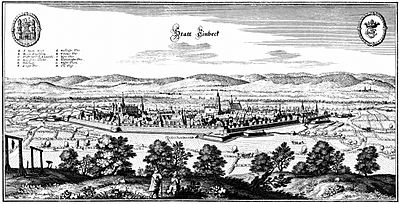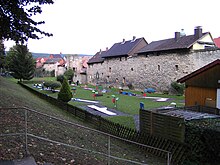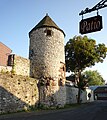City fortifications Einbeck

The city fortifications of Einbeck were a system of defenses for the city of Einbeck in the Middle Ages . It included a two-kilometer-long city wall, completed around 1300, with two dozen towers and five city gates . Outside the wall, the city was later expanded with ditches, ramparts and bastions, partly like a fortress based on the Dutch model . After the Seven Years' War (1756-1763) began the demolition of the fortifications with the demolition of the city gates. Nevertheless, around a third of the city wall with several towers as well as moats and ramparts have been preserved to this day. There are hardly any remains of the Einbecker Landwehr in the approach to the city .
City wall in the 13th and 14th centuries
The market settlement as the nucleus of the city of Einbeck was protected in the 12th century by a water-bearing, up to 4 m deep and 15 m wide, fortification trench.
Around 1250 the new town was included in a fortification system. This was done by an earth embankment about 2200 meters long with a 16 m wide and 2 m deep water-bearing ditch, which could be passed over wooden bridges in the area of the five city exits. The construction of the city wall began around the middle of the 13th century and was first mentioned in a document in 1264. The city wall, made of mortar limestone, was completed around 1300. Set on the earth wall, it enclosed the old and new towns and the St. Alexandri monastery district . The crenellated wall was about 2.2 km long and between 6 and 9 m high. It was about 1 to 1.5 m thick. On the city side, directly behind the wall, ran an undeveloped, passable street. Since the enclosed area crossed the Krummen Wasser floodplain, the water was diverted to the south around the fortification for almost a kilometer.
At least 22 towers were built to secure the city wall , the exact number of which can no longer be reconstructed today. They were at a regular distance of 60 to 70 meters and in places where the city wall bent. The towers were designed as square or semicircular shell towers open to the city side or as square closed flanking towers . For the first time in 1421 a residential use of the wall towers is reported, which later extended to the gate towers. It was only given up in the middle of the 18th century due to the poor state of construction of the facilities.
There were five city gates that were mentioned from 1318 and were used to control traffic. They had a passage width of two to three meters. These were the Ostertor and the Altendorfer Tor in the east, the Benser Tor in the south and the Hullerser Tor and the Tiedexer Tor in the west. The city gates were designed as gate towers which, like the wall towers, were made of white limestone with red sandstone edging. The towers had a roof covering made of black slate from the Harz .
Fortification-like expansion in the 15th and 16th centuries
While the fortifications of the city previously consisted of a vertical elevation of walls and towers, in the 15th century the use of powder weapons, such as artillery, led to horizontally structured fortifications (modern fortresses) with ramparts and ditches in front of the city wall, which became less important. The outer ring of fortifications in Einbeck was functional in the middle of the 15th century, as wall and gate towers were rented at that time and building sites were allocated on the inside of the city wall.
In the 14th century the inner city gates were reinforced with a front gate. At the beginning of the 15th century, an additional outer gate was built about 70 m in front of the inner gates. A trench 25 to 45 m wide was dug around the entire city and an earth wall just under three kilometers long, 20 to 60 m wide and 6 to 7 m high was raised.
At the beginning of the 15th century, several closed powder towers were built, which were only accessible from the city wall.
Around 1500 cannon bulwarks were built to counter the increasingly powerful cannons. In Ostertor one was battery tower , called Diekturm was to strengthen the Benser gate built and behind the cathedral church in the north emerged Ravens Zwinger and the High battery .
In the 17th century, at the time of the Thirty Years' War , the defenses were expanded in the manner of a fortress with horn works , smaller earthworks and roundels . These remained largely ineffective: the city was shot at and occupied several times. The Merian cityscape from 1654 shows a beautiful picture of the city, because it does not reflect the destruction and is incorrect in details, such as the number of wall towers.
Einbecker Landwehr
The Einbecker Landwehr as an outer defensive ring consisted of low trenches and hedge-lined walls. In the 15th century it closed the Einbeck field mark in an almost complete circle with a diameter of 7 to 8 kilometers and a circumference of around 23 kilometers. The passages on the important routes were secured by a total of seven stone waiting towers with a turnpike . The Landwehr fell into disrepair from the 17th century and was finally given up entirely in the 19th century.
Decay and current state of preservation
The Einbeck city fortifications were badly damaged in the Thirty Years War. In 1632 and 1641, parts of the fortifications and more than 300 houses were destroyed by cannon fire from the imperial troops under Pappenheim and Piccolomini . During the Seven Years' War, the city was repeatedly occupied by French troops who blew up significant parts of the city fortifications and the Landwehr on November 10, 1761 during the withdrawal under Duke de Broglie , including Raven's Zwinger , the rampart and the city wall south of the Easter Gate , the water tower and the outer Altendorfer Tor . The looped fortifications were finally not restored. The city council sold its cannons in 1741 to pay for the construction of a retaining wall for the market church tower. In 1760 the last municipal cannons and mortars had to be delivered to Göttingen. The city fortifications fell into disrepair after the Seven Years' War, although Einbeck was still a garrison town. Gates, walls and ramparts were removed and used as gardens until the late 19th century.
Nevertheless, significant parts of the city fortifications are still preserved, especially in the west and south of the city. The city wall with the towers is completely preserved between the former Tiedexer and the Hullerser Tor with the trenches and ramparts in front. A semicircular shell tower ( stork tower ) is still in full height in the southwest. The powder tower south of the former Altendorfer Tor is also completely preserved, while the bone tower, also used as a powder tower, north of St. Alexandri is only a few meters high ruins. The battery tower ( Diekturm ) still stands in the former Benser Tor at a height of 11 to 14 m with a diameter of 12.8 m. The remains of a gun emplacement ( upper cat ) have been preserved from the fortification of the Tiedex Gate . Large parts of the former ramparts are now used as parks. The preserved parts of the city fortifications are now a listed building.
Ruin bone tower
literature
- Andreas Heege : Einbeck in the Middle Ages . Isensee, Oldenburg 2002, ISBN 3-89598-836-7 .
- Monument topography Federal Republic of Germany, architectural monuments in Lower Saxony, Volume 7.3, City of Einbeck, edited by Thomas Kellmann, published by Stefan Winghart , Michael Imhof Verlag, Petersberg, 2017, ISBN 978-3-7319-0511-0 .










